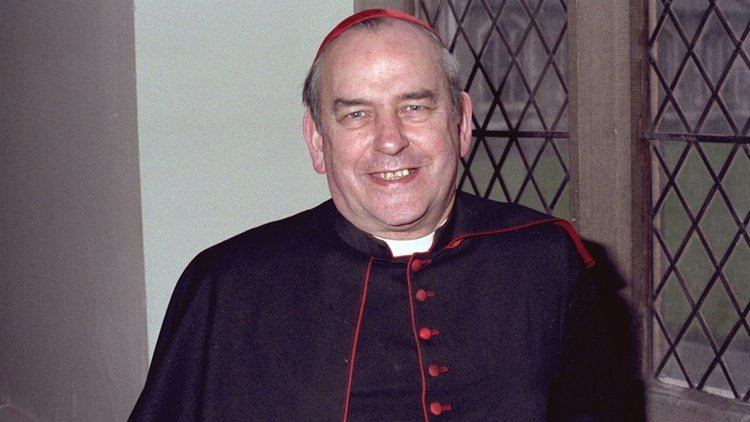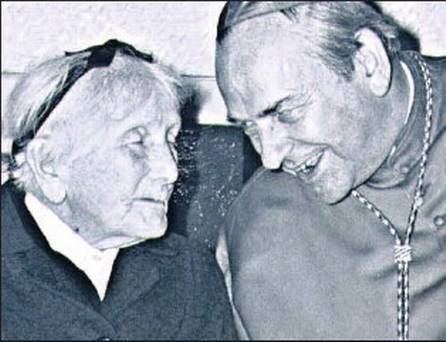Appointed 18 August 1977 Ordination 6 July 1948 (Priest) | Term ended 8 May 1990 Name Tomas Fiaich | |
 | ||
An ghaeilge tomas o fiaich scolairi phobalscoil ghaoth dobhair
Tomás Séamus Cardinal Ó Fiaich (3 November 1923 – 8 May 1990) was an Irish prelate of the Roman Catholic Church. He served as the Catholic Primate of All Ireland and Archbishop of Armagh from 1977 until his death. He was created a Cardinal in 1979. He was born in 1923 in Cullyhanna, and raised in Camlough, County Armagh.
Contents
- An ghaeilge tomas o fiaich scolairi phobalscoil ghaoth dobhair
- Priest president to archbishop
- Years as Archbishop of Armagh
- Papal visit 1979
- Criticism by Irish politicians
- Media criticism
- Hunger strikes
- David Armstrong affair
- Activities at the Vatican
- Advised about Father Sean Fortune
- Reordering of Armagh Cathedral
- Sudden death
- Cardinal Fiaich Library
- Cultrlann McAdam Fiaich
- Ancient Order of Hibernians
- Writings
- References
Priest, president to archbishop

Tomás Ó Fiaich (he began life as Thomas/Tom Fee but while a lecturer in St. Patrick's College Maynooth adopted the fully gaelicised version) was ordained a priest on 6 July 1948; he spent his first year of ordination as assistant priest in Clonfeacle parish. He undertook post-graduate studies in University College, Dublin, (1948–50), receiving an MA in early and medieval Irish history; he also studied at the Catholic University of Leuven, Belgium, (1950–52), receiving a licentiate in historical sciences.

In 1952 he returned to Clonfeacle where he remained as assistant priest till following summer 1953 and his appointment to the faculty of St Patrick's College, Maynooth. Tomás Ó Fiaich was an academic and noted Irish language scholar, folklorist and historian in the Pontifical University in St Patrick's College, Maynooth, the National Seminary of Ireland. From 1959 to 1974 he was Professor of Modern Irish History at the college. In this capacity he suggested to Nollaig Ó Muraíle that he begin research on Dubhaltach Mac Fhirbhisigh and his works. He "was an inspired lecturer, an open and endearing man, who was loved by his students... Tomas O'Fiaich was my Good Samaritan"

He served as vice president of the college from 1970 to 1974 and was then appointed college president, a post that traditionally precedes appointment to an episcopal position in the Irish Church. He held this position until 1977.
Following the relatively early death from cancer of Dr William Cardinal Conway in April 1977, Monsignor Ó Fiaich was appointed Archbishop of Armagh by Pope Paul VI on 18 August 1977. He was consecrated bishop on 2 October 1977. The principal consecrator was the papal nuncio Archbishop Gaetano Alibrandi; the principal co-consecrators were Bishop Francis Lenny, the auxiliary Bishop of Armagh, and Bishop William Philbin, the Bishop of Down and Connor. Pope John Paul II raised Ó Fiaich to the cardinalate on 30 June 1979; he was appointed Cardinal-Priest of S. Patrizio that same day.
Years as Archbishop of Armagh
Although Cardinal Ó Fiaich spent all of his formative years in academic circles, he proved to be an adept pastor. His tenure as Primate is often associated with the political strife rampant in Northern Ireland in the 1970s and 80s, along with the numerous episodes of child abuse and church governance. One incident often closely associated with the late Cardinal is the Hunger Strikes that occurred in 1981.
Papal visit 1979
The first major event in Ó Fiaich's cardinalate was the first ever papal visit to the Republic of Ireland from 29 September to 1 October 1979 by Pope John Paul II. The Pope celebrated Mass before one million people in the Phoenix Park, Dublin. His major speech calling on all the organisations that were prolonging The Troubles to end their activities was made in the Archdiocese of Armagh and was followed by a visit to the Marian Shrine at Knock, County Mayo. Cardinal Ó Fiaich was at the Pope's side during the entire visit.
Criticism by Irish politicians
Ó Fiaich took a more understanding, or at least a less critical, stance than other episcopal colleagues on militant republicanism in part because of his own upbringing in Crossmaglen. His approach, including visits to republican prisoners in the Maze, triggered many of these complaints but Ó Fiaich was always adamant that he had pastoral responsibilities and that the strict work of politics especially in an era of Margaret Thatcher as well Taoisigh such as Jack Lynch and Garret FitzGerald, was not his sphere. Unionists were also critical of Ó Fiaich.
Media criticism
Some of Ó Fiaich's sternest critics were in the Irish media, notably The Sunday Independent (which had very anti-militant stance) and The Irish Times . He was, however, strongly defended on occasion by The Irish Press (a more nationalist paper) and An Phoblacht (which had a very pro-Sinn Féin, pro-IRA stance).
Hunger strikes
During the IRA hunger strikes Ó Fiaich was believed by many to have been a privately influential figure among militant republican supporters, credited with helping end the first hunger strike through direct contact with militant republicans in the Maze Prison in Northern Ireland. He visited the Maze and witnessed the "Dirty Protest" (where prisoners rubbed their faeces on the walls of their cells and left food to rot on cell floors, while just wearing blankets and refusing to wash, in protest at the withdrawal of Special Category Status from militant republican prisoners). He stated:
"I was shocked at by the inhuman conditions . . . where over 300 prisoners are incarcerated. One would hardly allow an animal to remain in such conditions let alone a human being. The nearest approach to it that I have seen was the spectacle of hundreds of homeless people living in sewer pipes in the slums of Calcutta."[2]When hunger striker Raymond McCreesh died, Ó Fiaich said:

While the Cardinal showed deep concern for the treatment of prisoners, he was equally critical of those who used violence to further the cause of Irish nationalism.
David Armstrong affair
In 1983, the Reverend David Armstrong, a Presbyterian minister, was forced to leave Limavady due to threats that followed his wishing Father Kevin Mullan's Catholic congregation "Happy Christmas". Cardinal Ó Fiaich gave the clergyman a cash donation to help him resettle in England.
Activities at the Vatican
During his tenure, Cardinal Ó Fiaich attended many synods and meetings of the Sacred College of Cardinals. The main meetings were
Advised about Father Sean Fortune
Cardinal Ó Fiaich was advised by Gemma Hearne, a housewife in County Wexford, about the misbehaviour of Father Seán Fortune, but took no action. Several years after Ó Fiaich's death the Catholic sexual abuse scandal in Ireland became a matter of public debate.
Reordering of Armagh Cathedral
Ó Fiaich's re-ordering of the high Victorian neo-Gothic St. Patrick's Cathedral in Armagh proved very contentious. He had the highly decorated High Altar and rood screen replaced by a plain white Wicklow granite altar table.
Though Cardinal Ó Fiaich himself wrote approvingly of the new design for the sanctuary, many others were highly critical, arguing that the new sanctuary design defaced what had been a particularly fine nineteenth-century building, with the brutal simplicity of the white oval altar contrasting with the original features surviving. One critic, writing in The Sunday Independent, compared Ó Fiaich's altar to something from the set of Star Trek. The altar table installed during his time as Archbishop of Armagh was subsequently removed by Dr Seán Cardinal Brady and a more classical replacement installed.
Sudden death
Ó Fiaich died of a heart attack on the evening of 8 May 1990 while leading the annual pilgrimage by the Archdiocese of Armagh to the Marian shrine of Lourdes in France. He had arrived in France the day before and had complained of feeling ill shortly after saying Mass at the grotto in the French town. He was rushed by helicopter to a hospital in Toulouse, 125 miles away, where he died. He was aged 66. He lay in state at the cathedral in Armagh, where thousands of people lined up to pay their respects.
He was succeeded as archbishop and cardinal by a man six years his senior, Cahal Daly, then the Bishop of Down and Connor.
Cardinal Ó Fiaich Library
The Cardinal Tomás Ó Fiaich Memorial Library, a registered charity, was officially opened in Armagh 8 May 1999 by the Northern Ireland Secretary of State, Dr. Marjorie Mowlam. Named after the cardinal to honour his academic interests, it contains extensive archival material about Irish folklore, heritage and history. Cardinal Ó Fiaich's private papers covering his period as archbishop and cardinal are held by the library, as are those of nine previous Roman Catholic Archbishops of Armagh dating back to the mid-eighteenth century.
Cultúrlann McAdam Ó Fiaich
Cultúrlann McAdam Ó Fiaich is named in Cardinal Ó Fiaich's honour and is an Irish language cultural centre in which the first Irish-medium secondary school in Northern Ireland, Coláiste Feirste was founded. A bust of the cardinal can be seen in An Ceathrú Póilí, the centre's book shop.
Ancient Order of Hibernians
The Ancient Order of Hibernians, an exclusively Roman Catholic organisation largely (though not exclusively) based in the USA, has named its No. 14 Division in Massachusetts and No. 7 Division in New York City after the late Cardinal.
